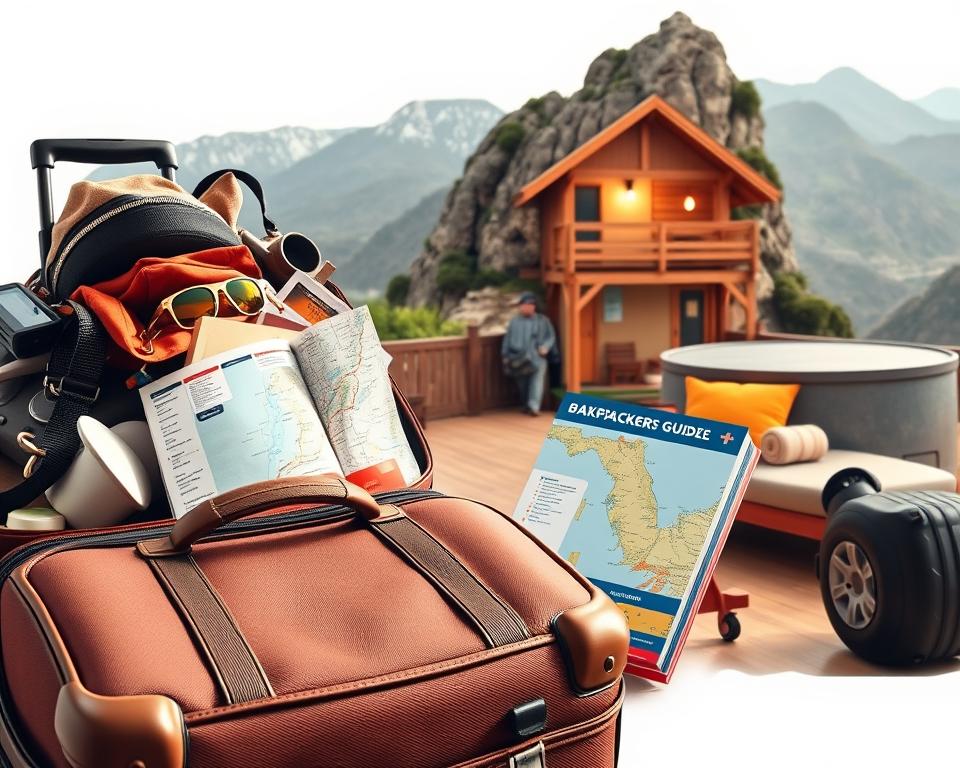Advertisements
Would you consider combining major capital cities and unexpected places in just three months?
In this article I give you a clear outline to plan a 90-day trip through the old continent without rushing.
I'll show you how to prioritize cities and countries based on your time, available months, and budget.
You'll find real options: low-cost airlines like Vueling, Ryanair, and EasyJet; buses like FlixBus; affordable trains in Italy; and accommodations from hostels to home exchanges.
I also explain the Schengen 90/180 rule and why it's key to your journey.
My tone is close and practical: you will find examples and forms to compare transportation and accommodation to make your days more productive.
Finally, I invite you to check the data and respect local regulations before leaving.
Introduction: Why a 90-day destination roadmap changes the way you travel
Planning three months in Europe changes the way you see each city and country. Instead of stringing together quick visits, your goal becomes choosing stories to tell, not just dots on a map.
When traveling to Europe With purpose, you transform the available months into purposeful blocks: art, nature, or the coast. This way, you make better use of your time and return with richer memories.
“Many travelers try to cover too many cities in a short time; prioritize quality over quantity and focus on one area whenever possible.”
- You'll learn how to measure what fits into 90 days and where to pause to avoid daily commutes.
- You'll see how to link logistically and thematically compatible cities for a smoother route.
- You will know how to identify signs of overload and criteria for leaving space for another occasion.
In short: travel methodically No It kills spontaneity; it frees it up so you can better enjoy every part of your journey.
Plan Architecture: Phases of Your 90-Day Roadmap and Key Tools
Break your journey down into simple steps and you'll see how each decision becomes manageable.
Preparation phase: Define what cities and countries are essential and how many days you'll dedicate to each stop. Budget by day and by trip in a spreadsheet (Google Sheets or Notion) and include a 10–15% buffer for unforeseen events.
Check documents: passport, insurance and renewals by year. Choose the area and the season depending on the weather and events; this affects prices and available time.
Execution and adjustment phase
Build the itinerary initial with metasearch engines (Skyscanner, Kayak), buses (FlixBus, Alsa, Eurolines) and train websites. Save each link and a example of rate to compare.
- Protect buffers: leave 1 day off every 10–12 days.
- Simple metrics: average cost per day, commute hours per week, and % non-commute days.
- Record what options worked and what local logistics means for future routes.
If a route increases in price, change the mode (train or bus) without losing sight of the objective. For more practical reading, see The first 90 days.
Requirements and regulations for travel to Europe: Schengen area, ETIAS, and the 90/180 rule
Before crossing borders, learn how days are counted within the Schengen area.
How space and the stay rule work
He Schengen area It brings together 26 countries with minimal internal border controls. It includes non-EU member states such as Norway, Switzerland, Iceland, and Liechtenstein.
The 90/180 rule means you can stay up to 90 days within any 180-day period. Count all your days in the zone; if you reach 90, you must leave until you make up for days.
ETIAS: what it is and who it affects
ETIAS is an electronic authorization for travelers exempt from visa. It will be valid for multiple entries for several years and will charge a fee. Check the exact effective date of 2025 with official sources before purchasing tickets.
Other common requirements
- Sure travel with medical coverage recommended for Schengen.
- Exit ticket, accommodation reservations, and proof of funds may be requested at random.
- Keep stamps and records to calculate your European days and avoid mistakes.
This article It is an educational guide: always confirm official requirements with the embassy or government website of the country you are visiting.
Budget and low-cost options: transportation, accommodation, and food without surprises
With a few simple adjustments you can stretch your budget without sacrificing trip quality.
Smart plane: Combine Vueling, Ryanair, and EasyJet and activate alerts on Skyscanner or Kayak. Change nearby airports for better prices and check baggage fees before purchasing.

Efficient train and bus
FlixBus and Eurolines are usually the cheapest options for overnight trips. Alsa is very useful within Spain.
In Italy, buy regional and Frecce trains in advance for a good price-to-time ratio.
Accommodation and collaborative stays
Hostels from €10–25 per bed; booking with flexible cancellation if your route changes.
HomeExchange reduces costs if you can swap homes. Workaway or WWOOF offer room and board in exchange for work in a specific area.
Eat well and cheaply
In the Mediterranean and Eastern Europe, markets and daily menus are cheaper than chains. Ask locals about neighborhoods with better value.
- Practical example: Flying to Milan-Bergamo and leaving via Rome often makes a multi-city trip cheaper; save each link reserve for comparison.
- Set a daily limit for food and transportation; record expenses and adjust them each week.
- If event fares go up, upgrade to a night bus or move a night to another nearby city.
Sample itineraries for your 90-day Europe trip
I propose real routes that balance culture, cost, and relaxation in 90 days.
Large capitals: Ideal for those who want iconic cities. Example distribution: Madrid (3), Paris (4), London (4), Berlin (3), Amsterdam (3), Rome (4). Add transfer days and 1–2 buffers.
Low-cost southern route
Mild weather and better prices during the off-season. Examples: Lisbon (3), Madrid (3), Barcelona (3), Rome (3), Florence (2), Venice (2), Athens (3). Add beaches during the warmer months.
Efficient central Europe
Short distances and frequent trains. Examples: Paris (3), Brussels/Ghent/Bruges (2), Amsterdam (3), Berlin (3), Prague (2), Vienna (2), Bratislava (2), Budapest (3). Use night trains to save on accommodation.
Cultural diversity and continent + islands
Combine heritage and sea: Granada (2), London or Paris (4), Sofia (2) or Moscow (depending on visa), Istanbul (3), Prague/Budapest (2–3), Edinburgh (2–3).
Final recommendation: divide your days by city size, prioritize key neighborhoods and museums, and keep track of your booked accommodations. Adjust the order by events and weather to optimize your European days.
Connection strategy: How to save time and days with a European travel itinerary
Optimizing connections gives you hours back for exploring, not commuting.
Use hubs such as Madrid, Paris, London, Rome, or Berlin to concentrate flights and reduce hotel changes. This way, you'll save time on transfers and more time to explore in the morning.
Hubs and strategic nights: fewer check-ins, more experiences
Plan nights close to stations or airports if you're leaving early. Sleeping 10–30 minutes apart can save you hours and stress.
Alternate 4-5 day bases with day trips. Fewer check-ins means more time in each city and fewer suitcases to move.
Schengen days control with non-Schengen sections and smart breaks
Integrate sections outside the Schengen area (United Kingdom, Ireland, Croatia, Serbia, Montenegro, Albania, Turkey) to pause the counting of days. Always keep an updated counter.
- Compare door-to-door times: early flight vs. fast train vs. night bus.
- Buy critical routes in advance and leave intermediate routes flexible.
- Consider open-jaw to avoid redundant returns in the same city.
Practical tip: If a connection fails, choose an alternative route through another country on the continent and recalculate the day count before purchasing.
90-Day Destinations Roadmap: Games, Fun Facts, and Insights to Learn Along the Way
Turn every city into a game: small challenges keep you engaged and curious throughout your trip.
Mini-challenges by city: museums, markets and neighborhoods
Create easy challenges: Visit two museums and a market at each stop. For example, the Prado + Mercado de San Miguel in Madrid or the Louvre + Marché des Enfants Rouges in Paris.
Design an Old World bingo: cross off themes like modern art, medieval quarter, and sunset viewpoint.
Location and season: auroras, festivals, and how to choose months
To see the auroras, choose late autumn or winter and cities like Tromsø or Reykjavik; reserve extra days for weather conditions.
Add festivals in spring and summer: music and film fill the streets. Check official calendars before choosing a month.
- Take walking or biking tours to understand the historical part.
- Practice “three local words” per country: say hello, ask, and thank you.
- Document every day with a photo, a lesson, and a local flavor.
Final tip: Alternate between quiet areas and nightlife neighborhoods. If it's raining, move challenges to museums and indoor markets and keep playing.
Conclusion
Close your plan with simple decisions that allow you to travel around Europe with more freedom and less stress.
You take A clear framework for prioritizing, measuring, and adjusting your travel itinerary without losing the essence of your European trip.
Remember to validate the requirements of the Schengen area and the Schengen area, and confirm if you need visa or ETIAS (planned for 2025) depending on your nationality and year of travel.
Keep your route flexible: European days and European months influence prices and availability. Check schedules, festivals, and performances with official sources before booking.
Think of your accommodation as a base for relaxation. Book tours with flexible policies and read recent reviews.
Travel responsibly: Protect the environment, respect communities, and compare data on official websites. Use this article as a starting point and tailor your plan to your energy and budget.



